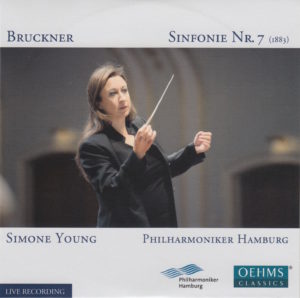
My “office” this morning is Baker Book House, which can be an extraordinary distraction for me. At any point as I sit here listening, I can jump up and go in search of a book in Baker’s immense Used Book section.
For a book nut like myself, that’s an ever-present temptation (and a very real possibility), believe me.
 So, this morning (as I fight off the temptation to browse the thousands of titles located 100 feet from me) I am listening to Anton Bruckner’s Symphony No. 7 in E Major (WAB 107), interpreted by Australian conductor Simone Young (1961-).
So, this morning (as I fight off the temptation to browse the thousands of titles located 100 feet from me) I am listening to Anton Bruckner’s Symphony No. 7 in E Major (WAB 107), interpreted by Australian conductor Simone Young (1961-).
Her orchestra is the Philharmoniker Hamburg.
I first encountered Maestro Young on this leg of my Bruckner journey on Day 5, Symphony No. 1.
Then again on Day 10, Symphony No. 2.
Then again on Day 16, Symphony No. 3.
Then again on Day 24, Symphony No. 4.
And again on Day 32, Symphony No. 5.
And again on Day 40, Symphony No. 6.
You can read what I thought of her interpretations by letting your mouse do the clicking on the various days above.
Or not.
It’s up to you.
Today is the seventh time I’m listening to a performance conducted by Maestro Young.
I previously wrote that I would not duplicate my bios of Ms. Young and her orchestra. Also, I will not again mention the problem with the CD booklet/liner notes. Or my solution to it. If you want to know about that, click the links above.
Again, or not.
Your choice.
From the splendid pdf liner notes written by Martin Stastnik that I downloaded from the OEHMS web site:
“… this will make you your fortune.”
Brief notes on Anton Bruckner’s
Symphony No. 7 in E majorNow we come to the Symphony in E major – not only the most popular work in the cosmos of Bruckner’s œuvre (with which, at most, the final version of his Fourth can compete), but also the symphony which laid the foundations for his international renown. It would not be entirely accurate to maintain that Bruckner had achieved no successes until his Symphony No. 7, nor is it true that the world premiere in Leipzig on 30th December 1884 was an immediate, uni- form and sweeping success, but No. 7 did fundamentally change every aspect of the composer’s public recognition from that moment on.
Here are the objective aspects of today’s recording:
 Bruckner’s Symphony No. 7 in E Major (WAB 107), composed 1881-1883
Bruckner’s Symphony No. 7 in E Major (WAB 107), composed 1881-1883
Simone Young conducts
Young used the ??? version. No version is listed in the CD booklet, on the CD sleeve, or in the pdf notes I downloaded from the web site
Philharmoniker Hamburg plays
The symphony clocks in at 66:32
This was recorded in Hamburg, Germany, on August 29 & 30, 2014
Young was 53 when she conducted it
Bruckner was 59 when he finished composing it (the first time)
This recording was released on the OEHMS Classics label
Bruckner wrote his symphonies in four movements. The time breakdown of this one (Symphony No. 7 inE Major), from this particular conductor (Young) and this particular orchestra (Philharmoniker Hamburg) is as follows:
I. Allegro moderato………………………………………………………………………………..21:38
II. Adagio. Sehr feierlich und sehr langsam…………………………………………..21:42
III. Scherzo. Sehr schnell………………………………………………………………………..10:24
IV. Finale. Bewegt, doch nicht schnell……………………………………………………12:45
Total Time: 66:32
Okay. Now, here are the subjective aspects of today’s recording:
My Rating:
Recording quality: 3 (personal preference, not technical shortcomings)
Overall musicianship: 4
CD liner notes: 2 (meager notes, confusing layout, essentially an “ad” for the Hamburg State Councillor of Culture and the Hamburg Philharmonic)
How does this make me feel: 3
I don’t know what I expected from today’s performance. But it seemed sleepy to me, especially the Adagio. It was lush, yes. Pretty, of course. But sleepy. (Although I will always love the ending to Bruckner’s Adagio from his Seventh. The pizzicato and horns combine in a sublime way.)
Or maybe the word I’m looking for is uninspired.
It took the rambunctious Scherzo to wake me from my daydreaming. But even that wasn’t particularly rousing.
I dunno.
I’m just not feeling it.
Part of the reason why is because I don’t like how it’s recorded. Not enough depth, space between the instruments. Some recordings – the ones I consider “magic” – sound 3D (3 dimensional). Some recordings – the ones that don’t move me – sound 2D (2 dimensional).
This is a 2D recording.
That written, I hope you realize this is 100% a personal preference. Others will hear this and hear 3D, and will love it. That’s because there’s nothing wrong with it. It’s a fine recording. Just not one I enjoy.
